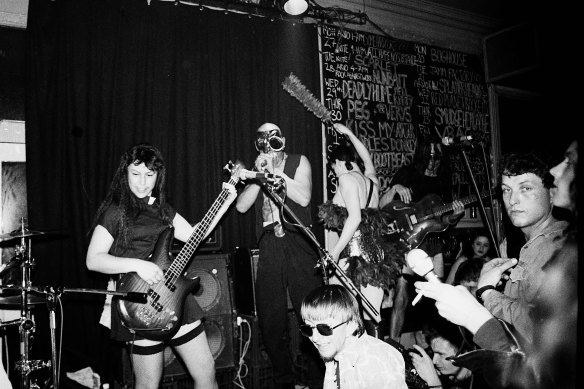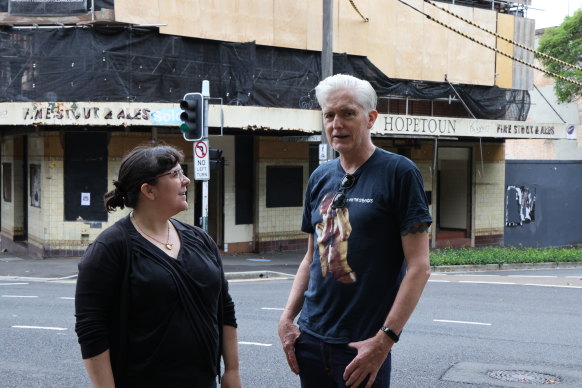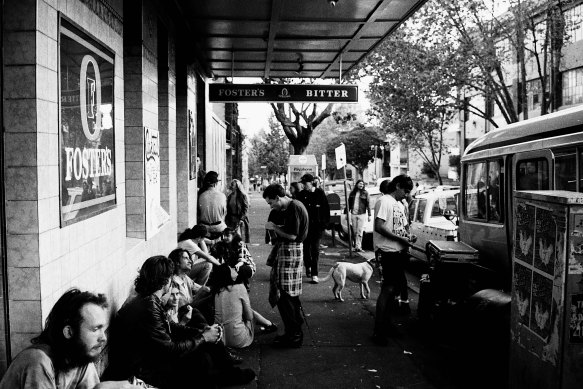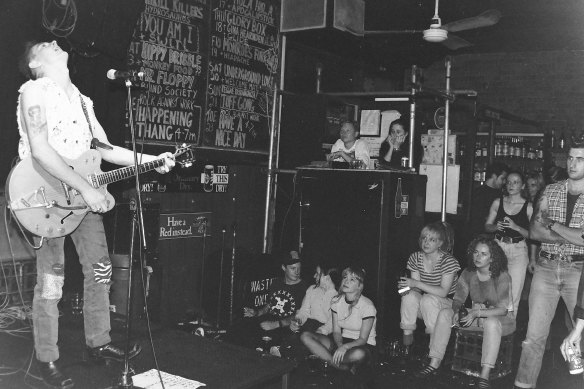
It was a summer evening in early 1992 when a guy picked a fight with me at the Hopetoun Hotel in Surry Hills for reasons now lost to the mists of time. We’d just seen Died Pretty play, and we were winding down with a couple of games at the pool table.
I was – and still am – a pretty scrawny specimen. This bloke could have snapped me like a twig, which he threatened to do as he started poking me in the chest with a blunt index finger.
At that moment, a diminutive figure intervened. Died Pretty frontman Ron Peno was roughly the same height and weight as Kylie Minogue, but after staring at my tormentor silently for a few moments with those intense, kohl-rimmed eyes and then quietly saying, “Leave Barry alone”, the guy backed down.

Back in the glory days you could catch a midweek show from Paul Kelly at the Hopetoun.Credit: Bryan Cook
“I’ll be waiting for you outside when you leave,” my would-be assailant said to me before disappearing with his mates.
An hour later, I took up the kind offer of Ron’s bandmate Brett Myers – who had the height and weight of an NBA basketballer – to escort me to my car a couple of blocks up Bourke Street.
And so ended another night at the Hoey, as everyone called it. To quote This Is Spinal Tap, “Don’t look for it; it’s not there any more.” Well, the building remains on the corner of Bourke and Fitzroy Streets. But no music has blasted through its band room since it closed in 2009, reportedly either the result of unpaid council fines for noise, or a disagreement between the two siblings who own the hotel, or perhaps a combination of both.

The official noise limit of 110 decibels was mostly honoured in the breach Credit: Bryan Cook
The end result is the same. For the past 15 years, the hotel has sat there, empty, silent and in a state of disrepair, a sad reminder of Sydney’s long-gone glory years as a live music mecca.
Now, the Hoey’s heyday is being celebrated at Vivid Sydney with an evening called Spirits Of The Hoey. A panel made up of musicians Sarah Blasko, Sally Seltmann and Clyde Bramley, plus photographer Tony Mott, will discuss the Hoey’s history and what the venue meant for Sydney’s music scene. And UTS academics Liz Giuffre (who is chairing the discussion) and Greg Ferris will show the work they’ve been doing on an immersive research project about the Hoey.
“We’ve filmed over 80 interviews with musicians, bar staff and punters,” says Ferris. “On the Vivid night, we’re going to be showing a teaser where we’ve placed our interviewees in a virtual version of the Hopetoun we’ve built using a game engine.”

Liz Giuffre and Greg Ferris are conducting a research project on the Hoey. Credit: Willow Ferris
“A lot of people we spoke to described the place as a loungeroom and social hub and compared it to CBGB [the epicentre of New York punk in the ’70s] as far as its layout and its influence,” adds Giuffre. “The Hopetoun was accessible and affordable. That’s what’s made it so special and made it an incubator. It was welcoming, and there weren’t barriers keeping people out.”
Memorable gigs and characters from the past kept cropping up in people’s memories –the pint-sized regular nicknamed Danger Mouse, who would dance maniacally and perform air guitar; Terry the Pieman, who would sell his tasty pastry treats to hungry punters at the end of the night; the low-lying ceiling fan that once chopped off the top of the towering hairdo of Stephen “Goose” Gray, frontman with Box The Jesuit; the much-loved Tuesday afternoon Rock Against Work gigs.
The official noise limit was 110 decibels, and the official capacity was 139 people, but both figures were rarely adhered to. For some years, the Hoey’s stage was little more than a board resting on milk crates. The sound was never great, and a column in the middle of the room obscured the sightlines. The toilets were notorious as the most disgusting of any Sydney venue.

The Hoey was much more than just a music venue for regulars.Credit: Bryan Cook
So what did the Hopetoun have that made it loom so large in the Sydney music scene?
“What the Hopetoun did, that no other venue did, was that it was so malleable it became whatever the audience was,” says Millie Millgate, who was the hotel’s booker from 1999 to 2004 and is now director of Music Australia. “You could have shoegaze indie-rock kids who thought it was their place, and the next night it would be full of full-on rock ‘n’ roll fans who thought it was for them, then there was experimental electronic music, and I even programmed a lot of hip-hop there. So it served all these different communities.”
It was also an egalitarian place. A lot of the bar staff were in bands, including Pat Hayes of Falling Joys and Jacob Stone of Bluejuice. Another big factor was the lack of separation between the band and the audience.
“There was no dressing room or green room,” says Millgate. “If you were performing there, you were in the pub with all the punters, and you walked through them to get to the stage. It created a community.”
Even before he ever got a gig there with You Am I, Tim Rogers remembers countless nights seeing bands such as X, Massappeal and the Hellmenn at the Hopetoun.
“My brother and I did the long drive from Baulkham Hills to Surry Hills,” he remembers. “The expectations on that drive were always high. And afterwards, the walk from the Hoey to Dimitri’s Pizzeria was well worn by both of us, to order a special with extra chilli.

There was little separation between punters and performers.Credit: Bryan Cook
“When we started playing there, the thing about the Hopetoun was that before and after the gig, you’d hang out and smoke and talk and meet people. It was small enough that you had to mingle. It was very social, and there weren’t many people at the Hoey who weren’t there for the music.”
When I recently put up a Facebook post asking for memories of the Hoey, more than 250 people responded, bursting with nostalgic reminiscences about what the place meant to them. One of them struck a special chord. Like many, Tia Koivisto, who was a regular in the early ’90s and became part of the hotel’s pool team, listed many of the great gigs she’d seen there, including The Beasts Of Bourbon, Glide, Crow, and many more. But she went a lot deeper into what the hotel meant to her.
“My huge, wonderful orphan family was found there, some of whom are lifetime friends,” she wrote. “I used to love the nights it was quiet, and I’d sit on the steps at the entrance of the poolroom with a drink and look across Bourke Street to Foveaux Street, and the pinkish-orange streetlights just made the area look so beautiful.”
She summed it up: “The best years of my life were spent there. It was home.”
Spirits Of The Hoey, at UTS Building 2 Events Space, June 4



























